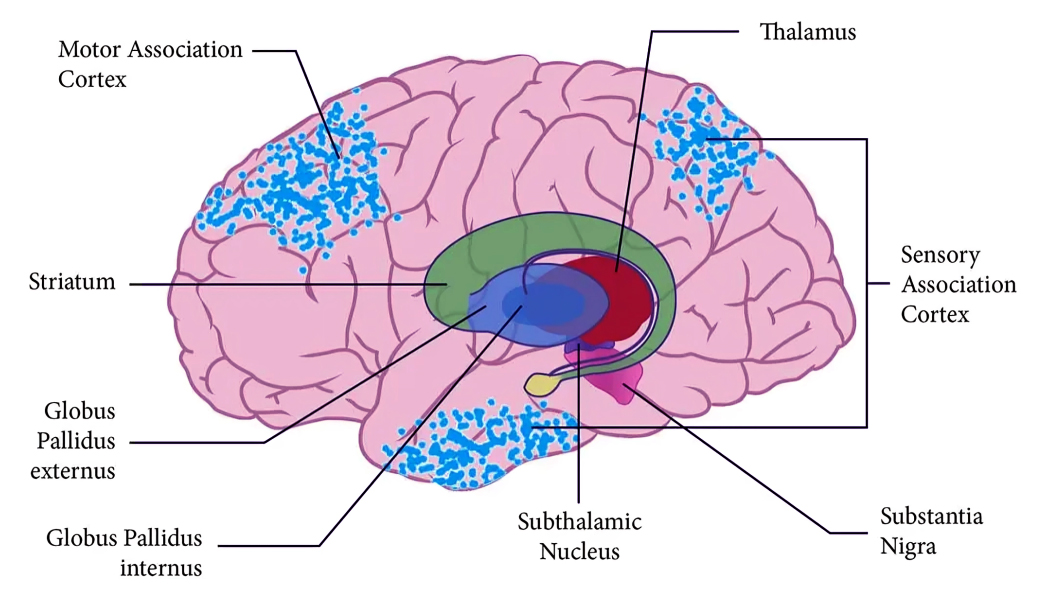
Thalamus Function: The brain is a complex organ that serves as the body's control center. It is divided into three main parts: the forebrain, midbrain, and hindbrain. The forebrain is further divided into two sections: the telencephalon and the diencephalon. The diencephalon includes the thalamus, hypothalamus, and pineal gland. The thalamus, a paired structure in the forebrain, functions as a relay center between the subcortical areas and the cerebral cortex. Thalamus Function NEET Biology Notes , including diagram, location, anatomy, and disorders, are provided in the article below.
What is Thalamus?
Thalamus is a large mass of gray matter located on the lateral walls of the third ventricle, forming the dorsal part of the diencephalon, a division of the forebrain. Nerve fibers extend from the thalamus to the cerebral cortex in all directions, known as the thalamocortical radiations, facilitating the exchange of information.
The thalamus consists of paired, egg-shaped masses located side by side. In a typical brain, each mass is approximately 3 cm long and 1.5 cm wide. It serves as the primary relay station for nerve signals from all the senses except smell. The thalamus sorts screens, and preprocesses the continuous stream of sensory information before passing it to the cerebral cortex.
The thalamus has several functions, including relaying sensory and motor signals to the cerebral cortex and regulating consciousness, sleep, and alertness. It is the predominant gray matter structure in the diencephalon, composed of various nuclei, each with distinct roles in information relay and alertness regulation.
Sexual Reproduction in Flowering Plants
Thalamus Diagram
Thalamus Diagram is as follows:

Anatomy of Thalamus
Thalamus is a structure located deep within the brain's center, acting as a relay station for sensory and motor information. It plays an essential role in consciousness, alertness, and sensory perception.
Situated in the diencephalon, a part of the forebrain above the brainstem, the thalamus consists of two egg-shaped masses on each side of the brain's midline. These halves are connected by gray matter called the interthalamic adhesion.
Gray and White Matter Composition
Thalamus is mainly made up of gray matter, which contains neuron cell bodies. This gray matter is divided into various clusters called nuclei, each serving a specific function. White matter, composed mainly of nerve fibers, separates these nuclei and connects the thalamus to other brain regions.
Internal Medullary Lamina
A notable feature within the thalamus is the internal medullary lamina, a Y-shaped white matter structure that divides the thalamus into three main regions:
- Anterior thalamus: Positioned between the arms of the Y-shape, it relays information related to limbic functions and emotions.
- Medial thalamus: Located on the inner side of the Y's main stem, it processes sensory information such as pain and temperature.
- Lateral thalamus: Found in the outer region of the Y, it is responsible for relaying sensory information like vision, hearing, and touch.
Structural Organisation in Animals
Thalamus External Layers
The thalamus is covered by two thin layers of white matter:
- Stratum zonale: This layer covers the upper surface of the thalamus and separates it from the epithalamus.
- External medullary lamina: This layer forms the lateral boundary of the thalamus, demarcating it from the internal capsule, a bundle of nerve fibers that connect various brain regions.
Nuclei of the Thalamus
The thalamus contains numerous nuclei, each with a specialized function. Some key nuclei include:
- Medial geniculate nucleus: Relays auditory information to the auditory cortex.
- Lateral geniculate nucleus: Relays visual information to the visual cortex.
- Ventral posterolateral nucleus (VPL): Relays touch, pressure, and proprioception information to the primary somatosensory cortex.
- Ventral posteromedial nucleus (VPM): Relays pain and temperature sensations to the primary somatosensory cortex.
- Dorsal medial nucleus (DM): Involved in memory, learning, and emotion.
The thalamus's anatomy highlights its critical role in coordinating sensory and motor functions, maintaining consciousness, and shaping our overall experience of the world.
| Important NEET Biology Notes | ||
|---|---|---|
| Selaginella | Embryo | Malvaceae |
| Pinus | Polyembryony | Volvox |
Thalamus Location
The thalamus is a pair of egg-shaped structures deep within the brain, positioned at the base of the cerebrum and above the brainstem. It sits centrally in the brain, with one on each side, and plays a crucial role as a relay station for sensory and motor information between the brainstem, spinal cord, and cerebral cortex. A detailed description of its Thalamus location is as follows:
- Forebrain: It is part of the forebrain, the largest and most complex part of the human brain.
- Diencephalon: Specifically within the diencephalon, which includes the hypothalamus, subthalamus, and epithalamus.
- Third ventricle: The inner surface of the thalamus forms the upper part of the lateral wall of the third ventricle, a fluid-filled cavity in the brain.
- Cerebral hemispheres: Situated between the two cerebral hemispheres, responsible for higher functions like thinking and sensory perception.
- Midbrain: Positioned above the midbrain.
| Important NEET Biology Notes | ||
|---|---|---|
| Chara | Funaria | Apomixis |
| Rhizopus | Spirogyra | Bacteriophage |
Thalamus Connections
The thalamus, a paired structure located near the center of the brain and positioned above the midbrain, facilitates connections between nerve fibers and the cerebral cortex in all directions. The two thalami are interconnected by the interthalamic adhesion.
The thalamus contains several nuclei essential for relaying sensory signals, with these nuclei being either inhibitory or excitatory. Thalamocortical neurons gather motor and sensory information from throughout the body and transmit selected data to the cerebral cortex via thalamocortical radiations.
Furthermore, the thalamus is connected to the mammillary bodies, hippocampus, and fornix through the mammillothalamic tract. This connection, involving the limbic system and the anterior nuclei of the thalamus, plays a key role in episodic memory and learning. Additionally, the thalamus regulates wakefulness and sleep.
Thalamus Function
The thalamus is a small yet essential structure located near the center of the brain. It functions as a relay station for information traveling between different parts of the brain and is involved in several critical processes. The thalamus performs the following functions:
1. Sensory Relay
The thalamus processes and transmits sensory information (except for the sense of smell) from the peripheral nervous system to the appropriate cortical areas.
- Visual: The lateral geniculate nucleus (LGN) of the thalamus receives visual information from the retina and relays it to the primary visual cortex.
- Auditory: The medial geniculate nucleus (MGN) processes auditory information and sends it to the primary auditory cortex.
- Somatosensory: The ventral posterior nucleus handles touch, temperature, pain, and proprioception (the sense of body position) and relays this information to the primary somatosensory cortex.
- Taste: The ventral posteromedial nucleus processes taste information and relays it to the gustatory cortex.
2. Motor Function
The thalamus receives information from the cerebellum and the basal ganglia and transmits it to the motor cortex, which is crucial for coordinating and executing voluntary movements.
- Effector nuclei: These nuclei are involved in administering motor language functions.
3. Regulation of Consciousness and Sleep
The thalamus helps regulate consciousness, alertness, and sleep by generating and maintaining the brain's electrical activity patterns seen in different stages of sleep and wakefulness.
- Intralaminar and reticular nuclei: These nuclei handle arousal and pain sensation.
4. Emotional and Cognitive Functions
The thalamus is connected to the limbic system, which is involved in emotions and memory.
Specific thalamic nuclei, such as the anterior nuclei, have connections with the hippocampus and cingulate gyrus, playing roles in memory formation and emotional regulation.
The dorsomedial nucleus has connections with the prefrontal cortex, contributing to cognitive functions such as decision-making and executive functioning.
- Limbic nuclei: These nuclei comprehend motivation and mood.
- Associative nuclei: These nuclei imply cognitive roles.
5. Pain Perception
The thalamus is involved in the perception and modulation of pain by receiving pain signals from the spinal cord and relaying them to the cortex, where they are processed and perceived.
6. Integration of Information
The thalamus integrates sensory and motor signals, coordinating complex processes and ensuring appropriate responses to stimuli. For example, integrating visual and auditory information enhances spatial awareness and the ability to react to environmental changes.
Clinical Relevance
Damage to the thalamus can cause various neurological and psychiatric conditions. A thalamic stroke can lead to sensory deficits, motor problems, and cognitive impairments. Thalamic dysfunction is also linked to disorders such as schizophrenia, where altered thalamic processing may contribute to symptoms like hallucinations and disorganized thinking.
In summary, the thalamus is a central hub for relaying and integrating information within the brain. Its extensive connections and diverse functions make it essential for sensory perception, motor control, consciousness, sleep, emotion, cognition, and pain perception.
Thalamus Disorders
Thalamus is an important part of the brain that serves as a relay point for sensory and motor information. It processes sensory signals such as pain, temperature, and touch before transmitting them to the cerebral cortex for interpretation. Additionally, the thalamus plays roles in alertness, sleep, and memory.
Damage to the thalamus can result in various issues, depending on the affected area. Here are conditions that can affect the thalamus:
- Stroke: This occurs when a blood clot obstructs blood flow to the brain, damaging the thalamus and causing problems with movement, sensation, and speech.
- Head injury: Injury to the head can harm the thalamus, leading to issues with memory, attention, and consciousness.
- Tumor: A tumor in the thalamus can press on nearby tissues, causing diverse symptoms based on its size and location.
- Infection: Brain infections like encephalitis can damage the thalamus, affecting movement, sensation, and consciousness.
- Multiple sclerosis: This autoimmune disease damages nerve fiber insulation (myelin sheath), impacting the thalamus and causing symptoms such as tremors, pain, and fatigue.
- Degenerative diseases: Conditions like Parkinson's and Alzheimer's can also damage the thalamus, resulting in problems with movement, memory, and cognition.
Symptoms of Thalamic Disorders
Symptoms vary depending on the specific cause and location of thalamic damage. Common symptoms include sensory issues (pain, numbness), movement problems (tremors, stiffness), speech difficulties, vision and hearing problems, memory impairment, concentration issues, sleep disturbances, fatigue, seizures, and even coma.
Diagnosis of Thalamic Disorders
Diagnosis involves a combination of medical history, physical and neurological examinations, blood tests, and imaging scans like MRI or CT to rule out other potential causes.
Treatment of Thalamic Disorders
Treatment depends on the underlying cause and aims to manage symptoms:
- Medications
- Physical, occupational, and speech therapies
- Surgery in certain cases
Early diagnosis and treatment are crucial for improving outcomes in thalamic disorders. If experiencing symptoms, seeking medical attention promptly is important.
Physics Wallah is known for the NEET Online Coaching at affordable prices. Enroll Now for effective NEET preparation.
| NEET Exam Important Links | |
|---|---|
| NEET Biology Syllabus | NEET Biology Diagrams |
| NEET Biology MCQ | NEET Biology Chapter wise Weightage |
| NEET Biology Notes | NEET Previous Year Question papers |
Thalamus Function
What is the primary role of the thalamus?
What is the thalamus in plants?
What are the divisions of the thalamus?
Where is the thalamus located in the human body?










